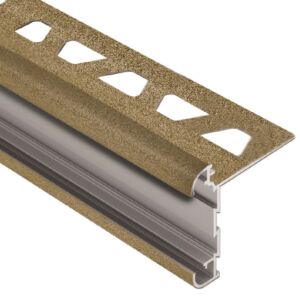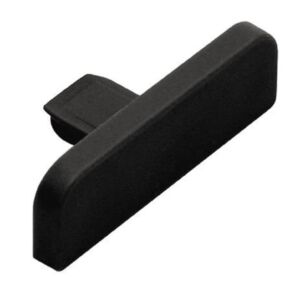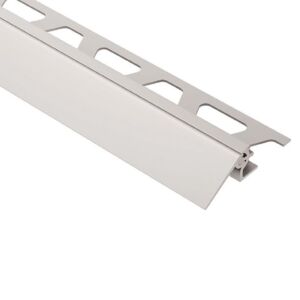Schluter TREP-SE Stainless Steel 1-1/32" Stair Nose Tile Edging Trim
Brand: Schluter
Availability: Ships from Factory (More Info)
Shipping: $49.95 Flat rate ground shipping for unlimited Schluter products in this order. Some exclusions apply.(More Info)
The Schluter TREP-SE Stainless Steel 1-1/32" Stair Nose Tile Edging Trim is designed to protect tiled stair edges and provide an easily visible, slip-resistant wear surface for a durable, safe, and visually appealing stair-nosing design.
The profiles feature a trapezoid-perforated anchoring leg made of aluminum which is secured in the mortar bond coat beneath the tile and supports a slip-resistant thermoplastic rubber wear surface. The tread surface of TREP-SE/-S/-B is available in a variety of colors and can be replaced in case of damage or wear.
The leading edges of TREP-S, TREP-SE and TREP-B have a 5/16" (8 mm) radius. Matching end caps are available.
Schluter TREP-S Features:
- Prevents tile edges on stairs from chipping
- Ensures a slip-resistant wear surface
- Features a trapezoid-perforated anchoring leg made of stainless steel (-SE) or aluminum (-S and –B) with a slip-resistant, thermoplastic rubber wear surface
- Ideal for offices, shopping malls, and other public areas
- Designed with a colored tread surface, which can be replaced in case of damage or wear (various colors available)
- Designed for areas exposed to heavy foot traffic
- End caps available
- Available in brushed stainless steel (-SE) or aluminum (-S or -B)
Schluter Edging Trim Installation
- Select the profile according to tile thickness and format.
- Using a notched trowel, apply thin-set mortar to the area where the profile is to be placed. If the JOLLY, QUADEC, RONDEC, RONDEC-DB, DECO-DE, FINEC, or FINECSQ profile is to be used as edging for an outside wall corner, finish tiling one wall first; then trowel thin-set mortar over the corner area of the second wall.
- Press the perforated anchoring leg of the profile into the mortar and align.
- Trowel additional thin-set mortar over the perforated anchoring leg to ensure full coverage and support of the tile edges.
- Solidly embed the tiles so that the tiled surface is flush with the top of the profile; the profile should not be higher than the tiled surface, but rather up to approx. 1/32" (1 mm) lower.
- Set the tile to the integrated joint spacer, which ensures a uniform joint of 1/16" - 1/8" (1.5 - 3 mm). With the stainless steel profiles, leave a space of approximately 1/16" - 1/8" (1.5 - 3 mm).
- Fill the joint completely with grout or setting material.
- Work with materials and tools that will not scratch or damage sensitive surfaces. Setting materials must be removed immediately, especially from aluminum.
Note: Matching corners and connectors are available. Corners are held in place with thin-set mortar. Fill the ends of the profile with thin-set mortar prior to inserting the accessories. Connectors are held in place with a friction fit. Insert the connector into the profile approximately half the length of the connector piece and connect the adjacent profile.
How do I cut profiles?
Schluter™ profiles are available in a variety of different materials , so methods for cutting vary. Below are best practices for cutting according to material type.
Plastic
Plastic profiles may be cut using Schluter™-SNIPS or similar. It is important to make sure the blade is sharp in order to ensure a clean cut.
Aluminum
One option for cutting aluminum profiles is to simply use a hacksaw. Look for a bimetal blade and select the highest teeth per inch, or TPI, available. A miter box is recommended to help ensure a straight cut. Aluminum profiles may also be cut using a variable-speed angle grinder with the Schluter-PROCUT-TSM cutting wheel. Set the angle grinder to the lowest speed. A clamp or cutting jig can be used to secure the profile and help ensure a straight, clean cut. Finally, aluminum profiles can also be cut using a chop saw or miter saw with a non-ferrous blade. After cutting, make sure to remove any burs with a file before installation.
Brass
Brass profiles can be cut by using a hacksaw with a bimetal blade with the highest teeth per inch available, or by using a chop saw or miter saw with a non-ferrous blade. Removing any burrs from the cut end of the profile with a file (or similar) is also recommended.
Stainless Steel
The simplest option for cutting stainless steel is to use a variable-speed angle grinder with the Schluter-PROCUT-TSM cutting wheel. Set the angle grinder to the lowest speed. Another option for cutting stainless steel profiles is to use a band saw with a metal cutting blade. After cutting, make sure to remove any burs with a file before installation.
| SKU | S TREP SE |
|---|---|
| Weight (lbs.) | 1.83 - 3.05 |
| Non-Returnable | No |
| Manufacturer | Schluter |
| Warranty | 5 Year Limited Warranty |
| Dimensions (L x W x H) | 4' 11" x 1 53/64" x 11/32" - 8' 2-1/2" x 1 53/64" x 17/32" |
| Trim Material | Stainless Steel/Thermoplastic |
| Trim Length | 4' 11", 8' 2-1/2" |
















